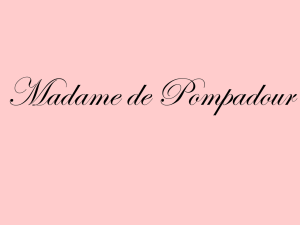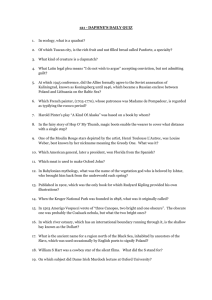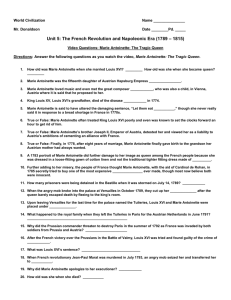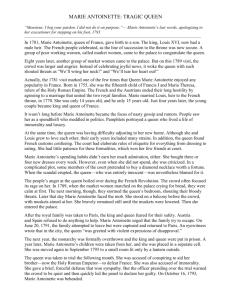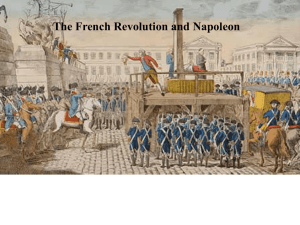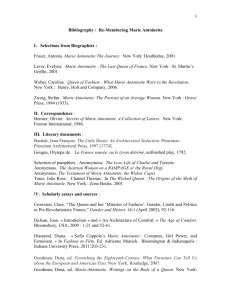Madame de Pompadour and Marie-Antoinette as Theater Directors
advertisement
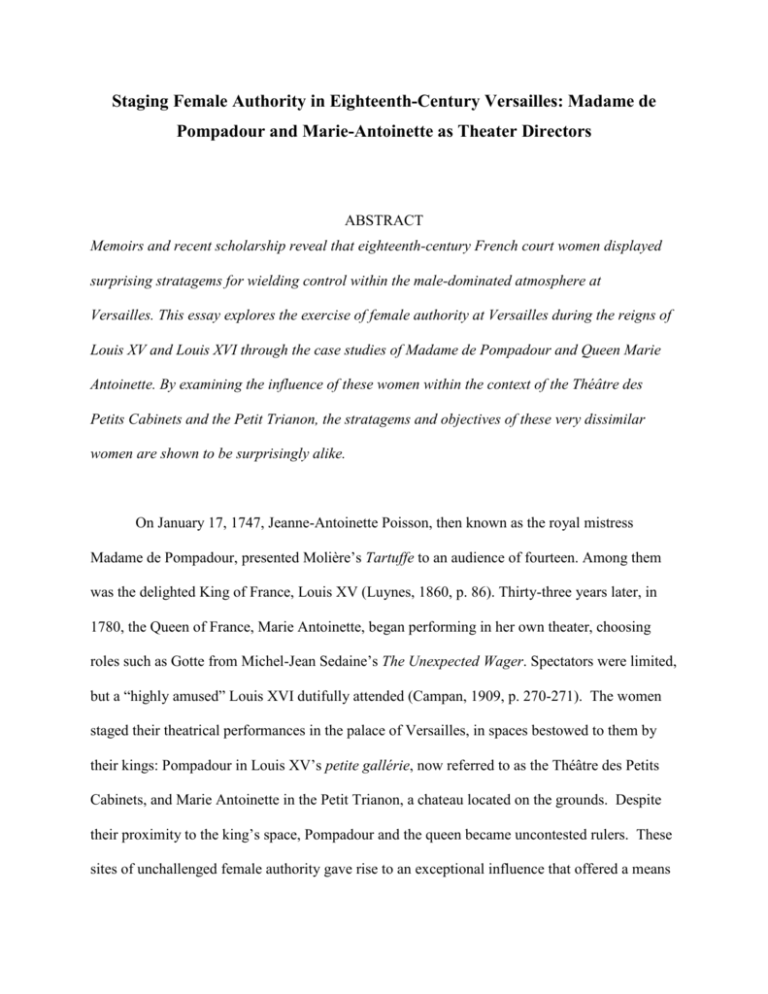
Staging Female Authority in Eighteenth-Century Versailles: Madame de Pompadour and Marie-Antoinette as Theater Directors ABSTRACT Memoirs and recent scholarship reveal that eighteenth-century French court women displayed surprising stratagems for wielding control within the male-dominated atmosphere at Versailles. This essay explores the exercise of female authority at Versailles during the reigns of Louis XV and Louis XVI through the case studies of Madame de Pompadour and Queen Marie Antoinette. By examining the influence of these women within the context of the Théâtre des Petits Cabinets and the Petit Trianon, the stratagems and objectives of these very dissimilar women are shown to be surprisingly alike. On January 17, 1747, Jeanne-Antoinette Poisson, then known as the royal mistress Madame de Pompadour, presented Molière’s Tartuffe to an audience of fourteen. Among them was the delighted King of France, Louis XV (Luynes, 1860, p. 86). Thirty-three years later, in 1780, the Queen of France, Marie Antoinette, began performing in her own theater, choosing roles such as Gotte from Michel-Jean Sedaine’s The Unexpected Wager. Spectators were limited, but a “highly amused” Louis XVI dutifully attended (Campan, 1909, p. 270-271). The women staged their theatrical performances in the palace of Versailles, in spaces bestowed to them by their kings: Pompadour in Louis XV’s petite gallérie, now referred to as the Théâtre des Petits Cabinets, and Marie Antoinette in the Petit Trianon, a chateau located on the grounds. Despite their proximity to the king’s space, Pompadour and the queen became uncontested rulers. These sites of unchallenged female authority gave rise to an exceptional influence that offered a means through which women could navigate the French court and insert themselves into the palace hierarchy. The Petits Cabinets and the Petit Trianon were more than mere entertainment outlets for the women. Kings built the locations yet gave them to their “favorites” to preside over, a task the women underwent with gusto: Pompadour and the queen radically altered the designs and purposes of their new playgrounds, tailoring them to represent and fulfill their own aspirations in Versailles. Both Louis XV and Louis XVI were invited and welcomed to their theaters, but neither could compete with the women’s power or claim superiority. Due to the presence of the king, the residing aristocracy of Versailles found inclusion in these sites as guests and cast members necessary for social advancement, but difficult to obtain. Courtiers become captive players in the court choreography led by Pompadour and Marie Antoinette, often reacting with collaboration for a role or slander when overlooked. Consequently, the figures of Madame de Pompadour and Marie Antoinette provide a fascinating case study for the exercise of female power through feminized, tailored spaces. For the purpose of my argument, I limit myself to those areas where the women exerted complete control: the Théâtre des Petits Cabinets and the Petit Trianon. Through analysis of memoirs of the time and recent scholarship, I explore questions surrounding their authority and challenges to it. How did Madame de Pompadour and Marie Antoinette gain legitimate power through these sites? What elements did they employ in tailoring these areas, and for what purpose? Did their direction over these small portions of Versailles lead to a larger control of the court? To what extent, if any, did the king reign within these private locations, and how did the French nobility react to this unique wielding of authorized female power? The theatrical nature of both locations also presents a series of issues to explore involving spectators, curious productions, and the perceived “teaching” of dissimulation and illusion to the king through women on stage. Madame de Pompadour and the Théâtre des Petits Cabinets Madame de Pompadour’s Théâtre des Petits Cabinets was a private space residing in one of the most public locations in France: the king’s residence at Versailles, tucked away in Louis’ former petite gallérie (Luynes, 1860, p. 87). Louis XV gave the theater to Pompadour, his maîtresse-en-titre, in the winter of 1747; a larger theater was built in 1748 (Londré, 1991, p. 108). Despite the theater’s location in the heart of French royal authority, Pompadour’s direction over the Petits Cabinets began with its conception and continued over production choices, rules, players, and audience (Kaiser, 1996, p. 1032). At an initial occupancy of only fourteen, the theater became a private, restricted association captured by the public imagination, particularly for the courtiers who were not extended an invitation (Londré, 1991, p. 109). To the French nobility, the Petits Cabinets came to represent Pompadour’s “greedy” control over the arts, courtiers, and by extension, the king and France. Pompadour quickly exerted her influence over the area. After the theater’s first production on January 17, 1748, a set of rules affixed with the royal seal was issued in favor of Pompadour and her actrices (Mitford, 1954, p. 99). Actors were expected to be punctual and were subject to fines imposed by the actresses; conversely, the actresses were allowed a halfhour grace and “subject to a fine…they themselves will fix” (Mitford, 1954, p. 99). Similar rules are found among the list, including one that stated, “works to be acted will be chosen by the actresses” (Mitford, 1954, p. 99). The implications of these policies indicate that Pompadour’s feminized theater held little room for male authority. This extends to the sway of the king as well: crafting of the rules aside, there is no indication that Louis was anything more than an eager, willing spectator to Pompadour’s theatrical gifts throughout the Petits Cabinets five-years of operation. Nor did Louis take issue with the theater’s actors. Marquis d’Argenson, Louis’s foreign minister from 1744-1747, wrote that the king “passes his time today watching the marquise and the other actors practice with all these professional clowns” (Kaiser, 1996, p. 1034). If Pompadour and her fellow actresses ruled the theater, it was Pompadour alone who chose the company members. With limited production and spectator space, this placed Pompadour in a position of great power over the courtiers, who vied for invitations to the Petits Cabinets troupe and by extension placement directly in the king’s gaze as he looked upon Pompadour. The duc de Luynes, a prominent courtier during this period, wrote of court figures such as the M. le maréchal de Noailles, who “earnestly requested to attend the little show”; he adds, unceremoniously, “he has been refused” (Luynes, 1860, p. 87). In his article Madame de Pompadour and the Theaters of Power, Thomas Kaiser (1996) notes that “courtiers sought to establish, retain, or improve their credit by playing roles and attending performances” but due to the theater’s three month seasons and Pompadour’s complete control of both cast and audience, it was difficult to secure an invitation (p. 1032). One limerick of the time reflects on this struggle, sighing, “to succeed at court/ [one] must bow before the idol/ The Princess Etoille” (Kaiser, 1996, 1032). So desperate were courtiers to be included in the productions, they were willing to work through another, more unusual avenue: the women close to Pompadour. Madame du Hausset (1825), a lady’s maid to Pompadour, wrote in her memoirs of a marquis who offered her an important exchange as she tried to secure a lieutenancy for a family member: I went out and the Marquis de V--, who was in [Marquis d’Argenson’s] closet followed me. “You wish to obtain a command,” said he; “there is one vacant, which is promised me for one of my protégés; but if you will do me a favor in return…I will give it to you. I want to be a police officer, and you have it in your power to get me the place.” I told him, I did not understand the purport of his jest. “I will tell you,” said he; “Tartuffe is going to be acted in the cabinets, and there is the part of a police officer, which only consists of a few lines. Prevail upon Madame de Pompadour to assign me that part, and the command is yours.” (p. 120-121) Hausset guaranteed nothing, but relayed the bargain to Pompadour, who assigned the marquis the role. He “thanked Madame as if she had made him duke” (Hausset, 1825, p. 121). This account is particularly interesting for what it infers about the women who held Pompadour’s ear. In exchange for the smallest of roles, Hausset was granted the position she sought for her relation but was unable to secure by her own authority. The Marquis’s protégé, once promised the post, was cast aside in favor of Hausset and Pompadour. Ultimately, the position was only a method for the Marquis to gain entry into the theater, and thus into Louis’s gaze. The traditional avenues of securing favors were now routed through Pompadour and her theater. This inversion of then-customary gender-restricted political clout displeased the courtiers, who attempted to dismantle Pompadour’s uncontested authority through malicious accusations. Some of the most damaging allegations centered on the “power” she was perceived to hold over the king through the theater. This “power” takes two forms: a flaunted physical control Louis was unwilling or unable to impose upon, alongside an “instruction” in duplicity, illusion, and dissimulation. Courtiers accused Pompadour of choosing plays that reinforced the idea of control through love over Louis. Many of these productions, such as Jean-Baptiste Lully’s opera Acis et Galatée and André Cardinal Destouches’s Issé, celebrated the idea of love conquering all (Mitford, 1954, p. 103; Londré, 1991, p. 108). Throughout the theater’s history, Pompadour always took starring roles, frequently playing love-struck heroines, pastoral nymphs, and even Venus, the Goddess of Love (Gutwirth, 1992, p. 88). The king’s status as “invitee” and not “inviter” to the Petits Cabinets romantically-oriented productions did little to allay these fears: by relinquishing control to Pompadour’s theatrics, the public conceived that “her seduction of the king’s mind and will” was rendering him politically impotent (Kaiser, 1996, 1034-1035). As an audience member, he was “held captive” by her performance and the feminized space she had tailored to achieve her ends; as a spectator, he was a “prisoner” who could but gaze upon her as she extolled their love’s “virtues” and “deceived” while in the guise of various characters unrelated to her station at court. A fellow actor, Pierre Laujon, used the highly charged, politicized word “conquest” to describe Pompadour’s relationship with Louis (Kaiser, 1996, p. 1036). In “Women, Gender, and the Image of the Eighteenth-Century Aristocracy,” Mita Choudhury (2006) records similar reactions to female “conquest” during this period, all of which hint at an underlying fear of “an inversion of nature, one in which powerful females and emasculated men dominated more virile exemplars of citizenship” (p. 185). The courtiers were also concerned by the “education” the theater taught a monarch already prone to “incapacitating melancholy and lethargy” (Kaiser, 1996, p. 1035). The comte de Cheverny, a close friend of Louis, wrote that Pompadour “had the great art of diverting the man of the kingdom most difficult to amuse…so that as soon as he could…he descended to her apartment through a hidden staircase and there shed the character of king” (Kaiser, 1996, p. 1035). This “transfer” of theatrics from their “correct” if not already disconcerting station in the Petits Cabinets to the king’s personal, private realms was fearfully viewed as what Madelyn Gutwirth terms “an enlargement of the stage on which [women] strutted” (Gutwirth, 1992, p. 78). This stage, now perceived to be present wherever Pompadour was, “educated” the king in what eighteenth-century philosophe Jean-Jacques Rousseau generally referred to as “the disorder of women”: dissimulation and “softness” which turns men into women (Rousseau, 1968, p. 100, p. 109). The intrusion of the “dishonest” feminine, private theatrical space directly onto the king’s public masculine authority was alleged to be a gross emasculation of the French monarchy. The marquis d’Argenson accused Pompadour of using this descent into the private “so that she could maintain her influence over the king and state policy” (Choudhury, 2006, p. 187). The duc de Cröy, maréchal de France, echoed this sentiment, but added an additional angle of theatrical deceit by stating that Pompadour “dabbled in many things without appearing to” by pretending to concentrate on her “little comedies” (Cröy, 1906, p. 59). We do not know how many, if any, of these accusations are true. What is confirmed is that Madame de Pompadour’s Petits Cabinets was an invitation-only space under exclusive female rule in the midst of Louis XV’s personal domain at Versailles. With leadership authorized and encouraged by the monarch, Pompadour and her chosen wielded an influence over the court that traded in a desire to be seen by the king. By retaining complete control of the Petits Cabinets, most notably in the form of invitations to its proceedings and a restricted cast list, Pompadour influenced the nobility and re-routed traditional avenues of court negotiation through herself. This exercise of power gave rise to the fear of Pompadour’s dominance over Louis XV, leading to her theater’s perceived role as a dishonest device through which to dramatically reverse accepted notions of gendered power, ensnare a lethargic king, and illegitimately govern France. Marie Antoinette and the Petit Trianon Originally constructed for Madame de Pompadour and later used by Madame du Barry, the Château du Petit Trianon was given as a coronation gift to Queen Marie Antoinette by her husband, Louis XVI, in June of 1774 (Weber, 2006, 131). As with the Théâtre des Petits Cabinets, the Petit Trianon stood on the public grounds of Versailles. It occupied a curious meaning in the French noble vernacular: a “domain…generally associated with the symbolics of Versailles”, but also “associated with the king’s pleasure” (Sheriff, 2003, p. 60). When the Petit Trianon was given to Marie Antoinette, this private location housed the public figure of the Queen of France, not a king’s mistress. Tailored through decoration, invitation, and lifestyle, the Petit Trianon served “as both a backdrop and a showcase for a conspicuously emancipated, empowered consort” (Weber, 2006, 132). Like Pompadour’s theater, Marie Antoinette maintained sole authority over the grounds – an authority to which even the king deferred (Weber, 2006, 134). The queen quickly modified the Petit Trianon to her own vision of escape. One of the earliest examples is the design and renovation of the grounds. Marie Antoinette transformed the traditional formal ornamental gardens into a jardin anglais suited to her personal taste. Though the “planned disorder” of the English Garden was popular in France due to the influence of JeanJacques Rousseau’s call for a “simple life,” in the hands of an already distrusted Austrian it was viewed as a “foreign import into the heart of the French symbolic space” (Sheriff, 2003, p. 60). One of Marie Antoinette’s ladies-in-waiting, Madame Campan, confirmed this impression of the Petit Trianon, recording in her Memoirs an amusing but telling incident in which a courtier confused the name of the retreat with the court’s derisive but prevalent nickname, “Little Vienna.” Believing the name official, the aristocrat addressed the queen in such terms; the queen, as expected, was displeased (Campan, 1909, p. 175). Love, and the worship of it, was also a predominant theme chosen for the Petit Trianon’s design. Like Pompadour’s performances as Venus and other incarnations of romance, love was heavily reflected in the Petit Trianon’s design. The grounds housed “lovers playing in the angles of the cornices…nests overflowing with roses and doves…the roses have no thorns, the arrows of love do not wound” (Roulston, 1998, p. 224). A dedication to “love” personified was present in the buildings, and even the guests, as well. In 1780, a sumptuous theater opened, providing Marie Antoinette with a private venue to play romantic heroines such as Rosine from Le Barbier de Séville (Campan, 1909, p. 137). The king was delighted by her transformations from stately queen to love-struck peasant – an echo of the pleasures Louis XV took from Pompadour’s masquerades (Weber, 2006, p. 137). Like Pompadour’s theatrical reign, Marie Antoinette personally oversaw casting and gave no regard to station at court. Several prominent courtiers were excluded from the proceedings; expecting more deference to their rank, the disregarded nobles found themselves irritated by who was allowed into the theater. They bristled at the inclusion of people like “the Librarian Campan”, who “acted as director and prompter, rather than some more suitable Duc” (Fraser, 2001, p. 179). Marie Antoinette’s tailored invitation list extended past the theater. She chose the Petit Trianon’s visitors with great care. Her “audience” regularly consisted of her closest friends and allies at court: in attendance were figures such as the Comte d’Artois, younger brother to Louis, and the Duchesse de Polignac, confidante to the queen and governess to the royal children. So too were foreigners invited, such as the Swedish Count Axel von Fersen, Marie Antoinette’s alleged lover, and the Princesse de Lamballe, Superintendant of the Queen’s Household and originally from Savoy (Weber, 2006, p. 136). Frequently missing were powerful members of the nobility like Cardinal Louis de Rohan, who resorted to masquerade as a means of gaining admittance to one of the queen’s private fetes (Weber, 2006, p. 138). Versailles’s nobility pursued invitations as they had hunted for Pompadour’s “few lines” in the theater, but found Marie Antoinette too devoted to complete withdrawal from the court to cater to their pleas. Faced with the queen’s staunch resolve in this matter, her affronted subjects believed they could not accept “banishment from [their] sovereign’s presence” (Weber, 2006, p. 138). On this, Madame Campan (1909) wrote: Marie Antoinette flattered herself that…she should possess a society formed according to her own taste. “I will receive them in my closet, or at Petit Trianon,” said she: “I will enjoy the comforts of private life, which exist not for us, unless we have the good sense to secure them for ourselves.” …All those courtiers who were not admitted to this intimacy became so many jealous and vindictive enemies (p. 208). By pursuing these “comforts of a private life,” Marie Antoinette was not merely abandoning the respect given to nobility. The Petit Trianon, traditionally a retreat for the king’s mistresses to host parties and indulge “in their own favorite hobbies and decorative whims,” became a stage on which to battle for independence from the court (Weber, 2006, p. 134). When presenting the Petit Trianon, Louis is said to have declared, “These beautiful places have always been the retreats of the King’s favorites,” a statement which unintentionally echoed Marie Antoinette’s rapidly approaching struggle between queen and mistress in the eyes of her subjects (Fraser, 2001, p. 151). The Petit Trianon became a symbol of this conflict, acting as a site of feminine autonomy and spectacle, but also intense court jealousies and public disapproval. Marie Antoinette also took certain liberties that Pompadour did not with her theater. Unlike the Petits Cabinets’ royally approved rules, all decrees issued from the Petit Trianon were solely “by Order of the Queen,” a feminization of a masculine monarchical decree (Weber, 2006, p. 134). Her personal cipher and the Hapsburg rose were prominently displayed, and the guards wore uniforms in scarlet and silver, rather than the red, blue, and white of the royal guard (Weber, 2006, p. 134). Louis himself could not enter the grounds unless invited by the queen, an act that transformed him in the eyes of his subjects from the King of France, master of his subjects and wife, to a cuckolded husband (Weber, 2006, p. 134). Personal autonomy over the king was not seen as Marie Antoinette’s only “agenda.” While at the Petit Trianon, and later the staged Hameau, she crafted an additional, unrelated persona in direct contrast to the one she was expected to play as queen and wife: that of a simple woman. She was known to dress in a simple pastoral style that suited her own desires, yet was far removed from the extravagant fashions of the Versailles court (Weber, 2006, p. 146). The birth of the couple’s daughter, Marie-Thérèse, in December of 1778, presented Marie Antoinette with another opportunity to escape to the simplified world she had created. She and Madame Royale frequently absconded to the hideaway, away from the nobility’s prying eyes, where the queen could raise her daughter in a “simpler” fashion. This seclusion presented its own set of problems: though Marie-Thérèse could not inherit the French throne, she was still a Fille de France, a position at court that demanded her public presence (Weber, 2006, p. 142). Retreating to the Trianon led to fears that the queen was “inculcating a French royal scion” (Weber, 2006, p. 142). This fanatical devotion to a private, unpretentious life challenged the natures of spectacle and spectator upon which the court was founded. By dictating the lifestyle at the Petit Trianon, Marie Antoinette asserted private authority over not only her own life, but also that of a child of France. This insistence on exclusion and the “simple life”, coupled with the queen’s complete authority over the Petit Trianon and who could venture beyond its locked gates, led to the most damaging accusation of all: while at the Petit Trianon, the queen was taking part in sapphic trysts that usurped the king’s position as husband. These allegations did not spontaneously brew in the streets of Paris, but germinated among the shunned courtiers: the author of the sensationalist pamphlet Portefeuille d’un talon rouge explicitly pointed to the aristocracy as the origins of these scandalous stories (Hunt, 2003, p. 125). Court gossip led to the publication of pamphlets such as the Mémoires secrets, which wrote of illicit trysts with female favorites who were welcomed at the Petit Trianon (Colwill, 2003, p. 149). Coupled with this perceived dissimulation was Marie Antoinette’s inability to fill the traditional role of wife and bear an heir to the throne – an heir who would become the Son of France. Elizabeth Colwill (2003) examines the perceived transgression of 18th century female same-sex acts in Pass as a Woman, Act like a Man, concluding that the idea of Marie Antoinette’s supposed sexual activities was an affront because she was “abandoning” men while assuming their sexual prerogatives (p. 148). Caroline Weber (2006) echoes the dual concept of “female” and “foreign” interloping on Versailles’ symbolic French form, concluding that the court resorted to these accusations because “whereas Louis XVI still did not have (and indeed would never have) a mistress, his ‘German’ spouse arrogated to herself two of his best-known royal rights: the right to seek pleasure with other women, and the right to bestow the most dazzling favors upon them” (p. 143). In the popular view, Marie Antoinette took her own “mistresses” and reveled in the emasculation of the men around by rendering them “unnecessary”. The feminized, tailored Petit Trianon, already associated with preference and mistresses, now represented the most egregious of female “crimes”: the creation of “a king and a kingdom ruled by women” (Landes, 1988, p. 33). By claiming the pleasures of private life in her own terms, Marie Antoinette was seen as playacting, deceiving, and perhaps worst of all, emasculating, usurping, and eclipsing the king’s power by rendering him “unneeded.” The Petit Trianon became a stage on which Marie Antoinette could perform her “ultimate betrayal of what the queen should represent” (Roulston, 1998, p. 226). Such accusations are now viewed largely as contrived propaganda against Marie Antoinette. Yet like Pompadour and her Petits Cabinets, the Petit Trianon remains a stunning example of female authority within the larger masculine French space. However, while Pompadour’s theater was a method through which the mistress could obtain court currency, Marie Antoinette negotiated personal power through the Petit Trianon’s structure and guest list, ultimately crafting her own private space as means of retreat from the court. Stages of Power In response to the question “Did women of the Old Regime have a political history?” Kathryn Norberg (2004) writes, “The answer is yes, but it is a history of exclusion and steadily diminishing opportunities” (p. 266). While this is generally true, there are moments in which women close to the king wielded elite, sanctioned power. Madame de Pompadour and Marie Antoinette, “favorites” of Louis XV and Louis XVI, obtained direction over locales that became sites of uncontested female rule. The Petits Cabinets and Petit Trianon present historians with viable locations of female authority in Versailles. With legitimacy granted through royal approval, the women acquired influence over other courtiers. Creating exclusive “enclaves,” they forced glory-seeking aristocracy to maneuver within their carefully constructed feminized spaces. Madame de Pompadour’s gendered list of company rules and Marie Antoinette’s invitation-only retreats represent decisive, uncontested moments of empowerment for these women in the Ancien Régime. Their authority was not restricted to boudoirs of private female refuge, but sponsored by kings and openly acknowledged by the nobility of the court. The spectacles that Pompadour and Marie Antoinette choreographed were viewed as both untouchable and corrupt. The Théâtre des Petits Cabinets and Petit Trianon presented surprisingly similar stratagems for the women to operate within the male-dominated French court yet left them vulnerable to defamation and slander. REFERENCES d’Albert, Charles Philippe, duc de Luynes. Mémoires du duc de Luynes sur la cour de Louis XV, edited by L.Dussieux and E. Soulié, 17 vols. Translated by Kelly Murray. Paris: 1862. Casid, Jill H. “Queer(y)ing Georgic: Utility, Pleasure, and Marie-Antoinette’s Ornamented Farm,” Eighteenth-Century Studies 30, no.3 (1997): 304-318. Campan, Jeanne-Louise-Henriette. Memoirs of Madame Campan on Marie Antoinette and her Court, edited by George Knottesford Fortescue and trans.?, Boston: J.B. Millet Company, 1909. Choudhury, Mita. “Women, Gender, and the Image of the Eighteenth-Century Aristocracy,” in The French Nobility in the Eighteenth Century: Reassessments and New Approaches, edited by Jay Smith, 167-188. University Park: The Pennsylvania State University Press, 2006. Colwill, Elizabeth. “Pass as a Woman, Act Like a Man: Marie-Antoinette as Tribade in the Pornography of the French Revolution,” in Marie-Antoinette: Writings on the Body of a Queen, edited by Dena Goodman. New York: Routledge, 2003. Du Hausset. The Private Memoirs of Mme du Hausset, Lady’s Maid to Madame de Pompadour. London: E. Wilson, 1825. Gutwirth, Madelyn. Twilight of the Goddesses: Women and Representation in the French Revolutionary Era. New Brunswick: Rutgers University Press, 1992. Goodman, Dena. “Not Another Biography of Marie Antoinette!,” in Marie-Antoinette: Writings on the Body of a Queen, edited by Dena Goodman. New York: Routledge, 2003. Hunt, Lynn. “The Many Bodies of Marie-Antoinette: Political Pornography and the Problem of the Feminine in the French Revolution,” in Marie-Antoinette: Writings on the Body of a Queen, edited by Dena Goodman. New York: Routledge, 2003. Kaiser, Thomas E. “Madame de Pompadour and the Theaters of Power,” French Historical Studies 19, No. 4 (1996): 1025-1042. Landes, Joan B. Women and the Public Sphere in the Age of the French Revolution. Ithaca: Cornell University Press, 1988. Londré, Felicia Hardison. The History of the World Theater: From the English Restoration to the Present. New York: The Continuum Publishing Company, 1991. Mitford, Nancy. Madame de Pompadour. New York: Random House, 1954. Norberg, Kathryn. “Incorporating Women/Gender into French History Courses, 1429-1789: Did Women of the Old Regime Have a Political History?,” French Historical Studies, 27, No. 2 (Spring 2004): 243-266. Roulston, Christine. “Separating the Inseparables: Female Friendship and Its Discontents in Eighteenth-Century France,” Eighteenth-Century Studies, 32, no. 2: (1998-99): 216-231. Rousseau, Jean-Jacques. Politics and the Arts: Letter to M. d’Alembert on the Theatre. Translated by Allan Bloom. Ithaca: Cornell University Press, 1968. Scott, Joan W. “Gender: A Useful Category of Historical Analysis,” The American Historial Review 91, no. 5 (December 1986): 1053-1075. Spawforth, Tony. Versailles: A Biography of a Palace. New York: St. Martin’s Press, 2008. Sheriff, Mary D. “The Portrait of the Queen,” in Marie-Antoinette, Writings on the Body of a Queen, edited by Dena Goodman. New York: Routledge, 2003. Weber, Caroline. Queen of Fashion: What Marie Antoinette Wore to the Revolution. New York: Picador, 2006. BIOGRAPHICAL NOTE Kelly Murray graduated from Coastal Carolina University in 2006 with degrees in History and Political Science. After serving as a Reference and Collection Management Assistant and Access Services Supervisor at Kimbel Library, she returned to classes at CCU and is now pursuing a degree in English.
